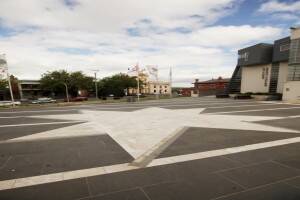
TEN years after the opening of the $30 million Camp Street Arts and Education Precinct, former city leaders have reflected on a vision never quite realised.It was an idea to bring life and activity to the centre of Ballarat, and it revolved around bringing students into the CBD through the University of Ballarat's arts academy.The precinct included the expansion of the Art Gallery of Ballarat and linking to Camp Street; creating a new public space known as Alfred Deakin Place; relocating UB's schools of visual and performing arts to heritage buildings in the precinct; and building new visual and performing arts facilities.Camp Street was the site of the original police camp and where settlement began in Ballarat.It was home to the city's significant public institutions, including the police station, law courts and trades hall.When the project was first mooted by the Kennett government, the police station, courts and post office buildings were empty.Former premier Steve Bracks said the whole precinct was iconic."We wanted to protect, preserve and upgrade the precinct," Mr Bracks said. "(Camp Street) is a beautiful part of the city with great historical relevance."After many years of planning, work officially began in August 2000.The opening of Alfred Deakin Place in 2001 was seen as the final step in transforming Camp Street into a place of history, community, art and education.A partnership was forged between federal, state and local government, and UB, to generate long-term economic, cultural and social benefits through arts and education.While the university says the precinct has been successful, others believe it has not reached its potential.David Miller was the City of Ballarat's general manager at the time of the project's planning and was responsible for looking after council's stake in the project."It was thought Camp Street might take on a new life; a cafe culture like in the (Sturt Street) 400 block," Mr Miller said."(It) was partially successful, but not to the extent we hoped."He said the motivation for the project was that there were major public buildings in the Camp Street precinct that had recently been or would soon be vacated."It was either going to be a potential disaster for Ballarat or to reinvent that part of Ballarat," he said.Mr Miller said the state government at the time, under Jeff Kennett, was pushing for the university to be involved in the project."Overriding that was to ensure that those buildings didn't become derelict, and the coincidence of the university in wanting to expand visual and performing arts, creating a hub, made it all come together very nicely," he said."Also a driving issue in this was that by having students and an art focus in the heart of the city, (it) would generate greater activity in the area."It hasn't matched the original vision, where there isn't that hub of activity."The best aspect of the precinct, Mr Miller believed, was that the Art Gallery of Ballarat doubled in size and so became a great legacy for Ballarat."Alfred Deakin Place hasn't been all that successful, as it's very exposed," Mr Miller said."At night time, there are problems with vandalism and it's never been quite the inviting space we hoped it would be."John Barnes was mayor of Ballarat during the project's planning phase, when it was imagined Camp Street would continue across to the Ballarat Railway Station."It was seen as desirable to acquire the (Godbehears) car yard and open the vista from Camp Street to the railway station," Mr Barnes said.But that plan was halted at the failure to purchase the car yard. Mr Barnes was sceptical of council's plans to redevelop Armstrong Street with the Town Hall Plaza, saying there was already a lot of potential in Alfred Deakin Place."It's like the Geelong waterfront - they persisted and it now works," he said. "The effort they're putting in to make it like what Alfred Deakin Place was going to be -there will be debate on whether they're doing it well."
Subscribe now for unlimited access.
$0/
(min cost $0)
or signup to continue reading

